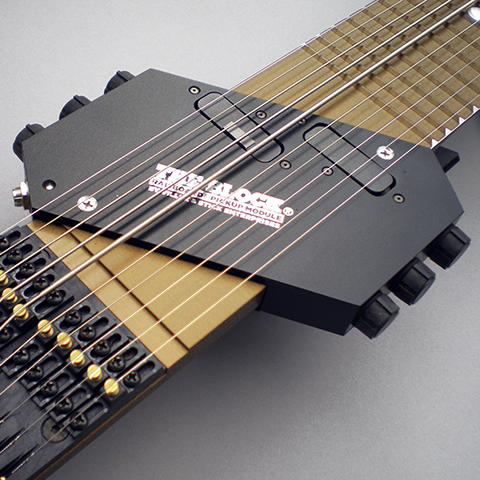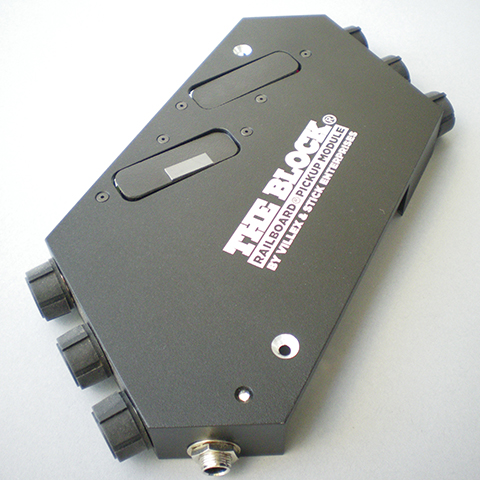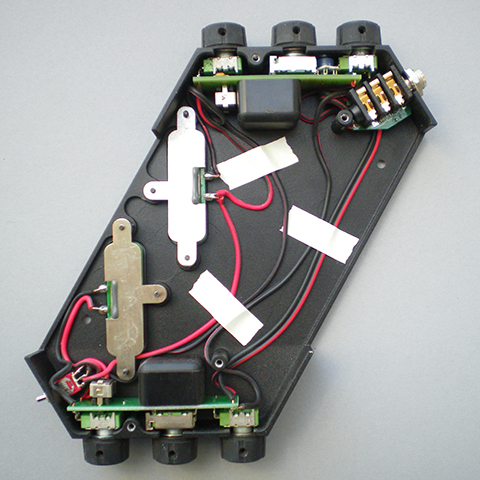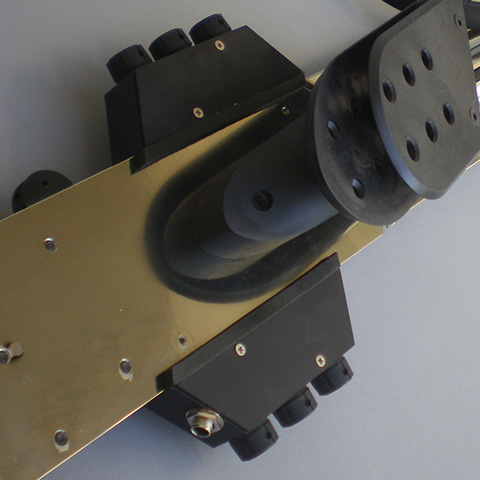Instruments Railboard® R-Block pickup
(No Longer Available.
This pickup has been replaced by the new EMG-RB10. Find out more.)
R-Block™, dual Villex pickup module with voiced filters and passive or active operation
For many years our PASV-4 Block module has offered Stick players the distinctive full-range high-output sound of Villex passive pickups, as well as the module's uniquely musical filtering, all designed and manufactured by Villex founder William Khanagov. The Railboard incorporates two Villex pickups, one for each set of strings. Each pickup has volume control and a new and versatile midrange tone shaping circuit (described below).
For most users, plugging in is simply a matter of running the Railboard's split bass and melody outputs through your favorite guitar and bass effects and amplifiers using a standard Stick cable. There is also a new kind of an ACTIVE mode which allows direct balanced connection via an XLR cable to a PA system or the microphone inputs on a studio mixer, high-quality mic preamp or computer digital audio interface.
For most users, plugging in is simply a matter of running the Railboard's split bass and melody outputs through your favorite guitar and bass effects and amplifiers using a standard Stick cable. There is also a new kind of an ACTIVE mode which allows direct balanced connection via an XLR cable to a PA system or the microphone inputs on a studio mixer, high-quality mic preamp or computer digital audio interface.
OVERALL SHAPE
Villex and I have designed a radically new wrap-around "R-Block" module for the Railboard's pickups and electronics. Its diagonal, chopped rhomboid shape is now reversed compared to our previous modules, with the stereo output jack on the opposite side, near the bridge and off to the player's right side. Two low-profile Villex pickups are at the "neck" position, with the melody pickup now closest to the highest fret Rail (for a full and mellow tone), and the bass pickup now an inch further away (for a full sound with bit more "bite" than the melody pickup).PICKUPS AND ELECTRONICS
Two self-contained PC boards, each with three controls, fit snugly into pontoon-like side extensions, one for each string group. A slim top Block surface crosses over a shallow cutaway channel on the aluminum neck beam, connecting the "pontoons" on either side, also aligning the pickups in place under the strings. The underlying aluminum through-neck beam is 5/8" thick at this area with shallow excavations to contain the new low-profile Villex pickups. Three-dimensional adjustments of the pickups are set with three height-adjustment screws around each pickup. These allow very close positioning under the thinnest strings, lower positioning under the heavier strings, and tilt relative to the plane of the strings.TONE AND VOLUME
Villex's advanced magnetic technology and innovative electronic circuitry provides a rich variety of tones both "acoustic" and electric in character. Each pickup has three control knobs, one for volume and two for tone, including (1) a pot to gradually boost or cut the lower mids, and (2) a 4-position rotary switch for three vowel-like resonant peaks (as in "cat, cot, caught") plus a bypass position for Villex's laser pure, full-frequency sound. Volume is strong with a high signal-to-noise ratio, and tone is not affected by volume control roll-off.STEREO AND MONO OPERATIONS
A toggle switch changes the mode from stereo to mono. A trim pot on the bass side can be set with a screwdriver to reduce the mono bass volume until it balances with the melody. The mono output can be sent through either the tip or ring of the output jack, or through both together, simply by operating the volume knobs on each side, thus panning the combined mono signal anywhere across the stereo field. With the bass volume turned off, the mono signal gets panned to the melody amp or channel (hard left or right). With the melody volume off, the mono panning is hard in the other direction (the bass side output). With this setting a standard guitar cable can be used to run the mono bass with melody into a single amplifier channel. Also, the tone controls for both sides can be combined in mono mode for more complex filtering effects that will apply equally to both sets of strings.PASSIVE OR ACTIVE — a direct connect to effects, amplifiers, P.A. system or your digital audio workstation
As with all of our Stick instruments you can connect the Railboard outputs to your favorite guitar and bass processors and amplifiers with the provided stereo 1/4" Y cable. In addition, Villex has designed and built an amazing piece of new technology into the "R-Block" and I've decided to include it as a standard Railboard feature. A special circuit in the stereo jack senses incoming phantom power when plugged into the mic inputs of a mixing console and automatically "flips" the pickups module to an active mode, powered by the mixer, audio interface or microphone preamp.A blue LED on the module lights up to let you know that the pickups are now in active mode (no direct box needed). All stereo and mono settings and operations are identical in passive and active modes.
The ACTIVE mode will allow you to avoid impedance mismatches that can occur when plugging a passive pickup into the line-level 1/4" jacks found on most mixing boards and audio interfaces. It will also enable long cable runs, such as through a snake into a P.A. without signal degradation. Just walk on stage and plug in a single XLR mic cable and let your sound man at the other end of the room do the rest, or take advantage of the high-quality, phantom powered mic preamps in your studio console or computer audio interface.
All you need for the R-Block's ACTIVE mode are two adapters that are included at no extra charge with each Railboard instrument:
1) A 6-foot long stereo adapter cable (quarter-inch TRS to male XLR), to plug into a longer mic cable or our XLR splitter cable. 2) A 10-inch long stereo splitter (XLR-F to dual XLR-M Y-cable) custom configured to attach at the far end of the mic cable and send separate bass and melody signals to separate channels of a mixer, audio interface or snake. We also have standard 50-foot mic cables that sell for $35., in case you need one.




